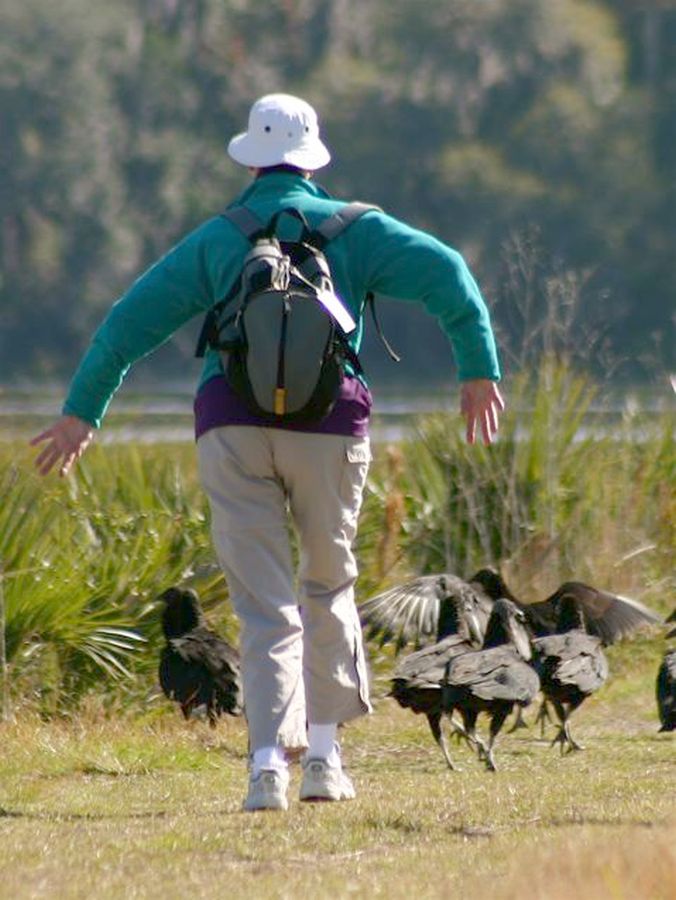
27 February 2008
In the past six days I’ve been in Florida — looking at birds of course.
By the end of February I’ve had enough of Pittsburgh’s relentless gray skies and cold weather so I visit my friends Chuck and Joan Tague who spend the winter near Daytona. Birds + friends + warmth are such a welcome break!
Humans aren’t the only ones who escape to Florida. A lot of birds spend the winter there, especially the turkey vultures (Cathartes aura) and black vultures (Coragyps atratus).
Turkey vultures are common in western Pennsylvania from March to November but they spend the winter in the south because they can’t eat frozen food. Vultures eat rotting dead things, the more rotten the better. Freezing weather preserves the meat – therefore no rotting – and vultures’ beaks are not strong enough to break apart tough substances, so they go south.
But if it’s possible to have favorites among such ugly birds, mine are the black vultures. They are less shy than turkey vultures, they have timid-looking faces and they are rare in western Pennsylvania. I suppose absence makes my heart grow fonder. I don’t have to deal with them all the time.
Near Daytona there are two places where I’m guaranteed to see lots of black vultures: Lake Woodruff National Wildlife Refuge and at my hotel’s parking lot. This has nothing to do with the hotel and everything to do with the fast food restaurants nearby. The black vultures roost overnight on cell towers and pines and coast down to the restaurant dumpsters in the morning. Sweet and shy as they look, I don’t get too close because they projectile-vomit when frightened. I don’t want to be on the receiving end of that!
At Lake Woodruff I can get a little closer. The vultures sit in flocks on the dikes and as we approach they hop away, sometimes holding their wings open and skipping ahead of us. They look so silly that I had to imitate them. Chuck snapped my picture.
Oh well. You’re never too old to have fun.
(photo by Chuck Tague)
Have you ever been to the St. John River when you’re down FL? That’s a great tour by boat–lots of water birds, and other birds (incl. raptors) besides the gators, otters, etc. They also have a small inlet area near the boat launch site that manatees frequent in the spring. I believe it is near DeBary or Deltona, in Orange City/County, which is inland but on same “level” as Daytona.
I’ve been to a place called Blue Spring State Park near Orange City which sounds a lot like what you’re describing. I’ve seen the manatees and taken a boat tour there. The website is at http://www.floridastateparks.org/bluespring/default.cfm
That’s it. What did you think about it? St. Augustine is also very nice and I stayed in Palm Coast a while once which is more like suburbs and was expanding unfortunately. On About.com there’s a forum about birding/wild birds with some very interesting people and information. One woman lives in FL and she often posts some gorgeous photos of not just birds, but dragonflies, lizards, etc.
I intersted in your Vulture and Frozen Food theory. We have both in south central PA in the winter, though in the winter the Black’s outnumber the Turkey’s, and while our winters are a tad milder than in Pittsburgh it is not that different. Is this frozen food theory something you have read or your own summizing?
Per Cornell Lab’s Birds of North America Online, turkey vultures are partially migratory. They are cold-hardy but move south “probably in response to drop in temperature (see Tyler 1937), to snow cover, and to winter storms; frozen carcasses are hard to eat.”
Interestingly, both species of vultures have a wider range in South America than they do in North America and they stay there all year. The turkey vulture’s range extends to Tierra del Fuego. Both species are expanding their summer ranges northward, so perhaps we’re actually seeing South American birds invading North America.